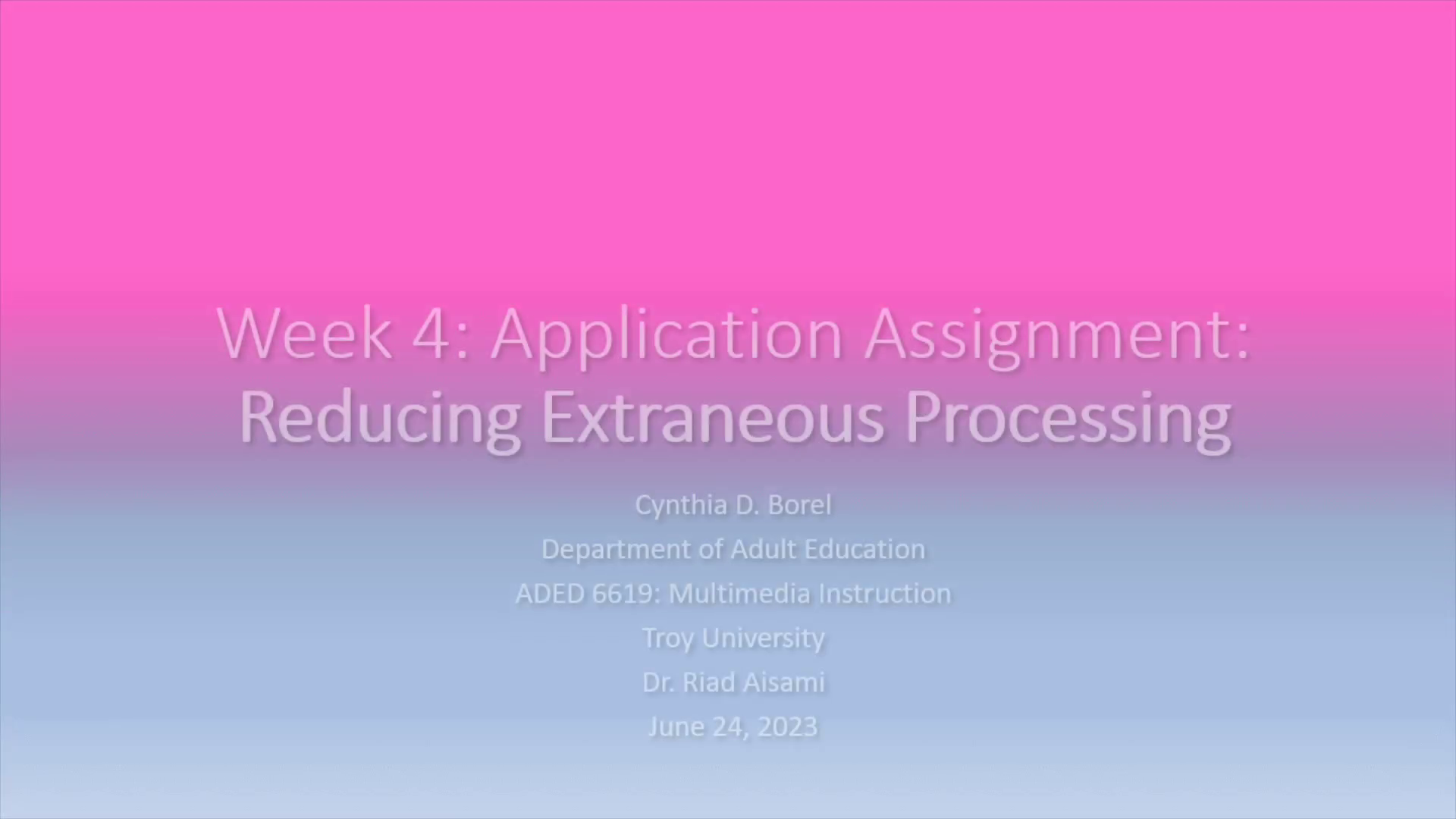
Week 4: Application Assignment: Reducing Extraneous Processing
Scene 1 (0s)
[Audio] . Hello, I am Doctor Cynthia Borel, I am your instructor for the Week #4 Application Assignment: Mayer's three principles for extraneous cognitive processing (or simply, extraneous processing). Extraneous Processing refers to cognitive processing that does not support the instructional goal and is caused by poor instructional design. If extraneous processing consumes all of the learner's available cognitive capacity, then the learner is not able to engage in cognitive processes for learning such as selecting, organizing, and integrating. The result, is no learning, which is reflected in poor retention and poor transfer performance (Mayer, 2021, p. 51). Today, we will talk about these elements and how to avoid them in your presentation..
Scene 2 (49s)
[Audio] Our objective for today is that upon completion of this presentation, the learner will be able to define principles of extraneous processing and ways to avoid/reduce it based on Mayer's Principles: Coherence principle Signaling Principle and Redundancy Principle.
Scene 3 (1m 9s)
[Audio] Coherence is an essential aspect of effective communication and presentation design. In the context of Mayer's principles, coherence refers to the logical flow of information and ideas. A coherent message is one that is easy to follow and makes sense to the audience and does not necessarily include background music, lengthy stories, or other irrelevant information. To achieve coherence, it is important to organize your content in a logical manner. This can be done by using transitional phrases and connecting words to link ideas together. Visual aids such as diagrams and flowcharts can also help to illustrate the relationships between different concepts and make the message more coherent; but can also be confusing if the visual aid does not add substance to the material..
Scene 4 (1m 59s)
[Audio] Signaling refers to the use of cues or indicators to convey information to the audience. These cues can be verbal or nonverbal, and they play a crucial role in helping the audience understand the message being conveyed. In the context of Mayer's principles, signal by providing multiple cues or indicators that reinforce the same message, the speaker can increase the likelihood that the audience will understand and remember the information being presented. For example, using both visual aids and spoken explanations can help to reinforce key concepts and improve overall understanding. Emphasize keywords by increasing tone and/or highlighting keywords..
Scene 5 (2m 40s)
[Audio] Redundancy is an important principle in communication and presentation design. It refers to the act of repeating information using different modes of representation, such as text, images, and audio. Avoid duplication. Use text, images, and audio to emphasize key points..
Scene 6 (3m 5s)
[Audio] In conclusion, we have discussed the three important principles for extraneous cognitive processing: coherence, signaling, and redundancy. These principles are essential for creating effective and engaging presentations that capture and maintain the audience's attention without overloading. By using these principles, you can ensure that your message is clear, memorable, and impactful. Coherence helps to connect ideas and concepts, signaling draws attention to important information, and redundancy reduces duplication and aids in retention. Remember, effective communication is not just about what you say but how you say it. By applying Mayer's principles, you can create presentations that are not only informative but also engaging and memorable. For more information go to: h-t-t-p-s-:/-/-p-s-y-c-n-e-t-.-a-p-a-.-o-r-g-/record/2015-00153-012. Go forth and apply these principles to your next presentation, and watch as your audience becomes captivated by your message..
Scene 7 (4m 8s)
References. Mayer, R. (2021). Multimedia learning. Cambridge University Press. Kindle Edition..